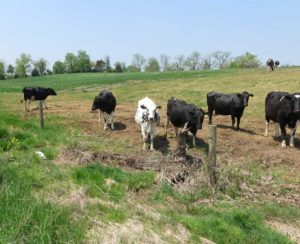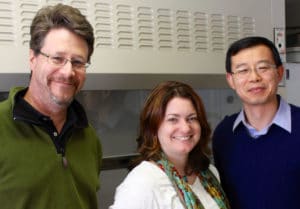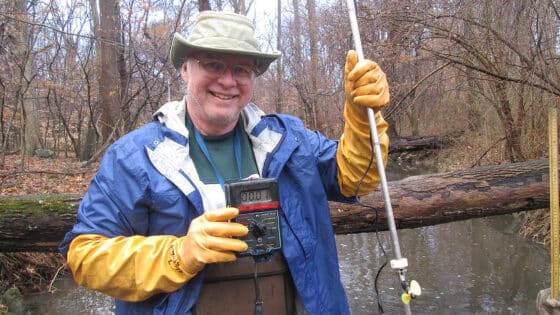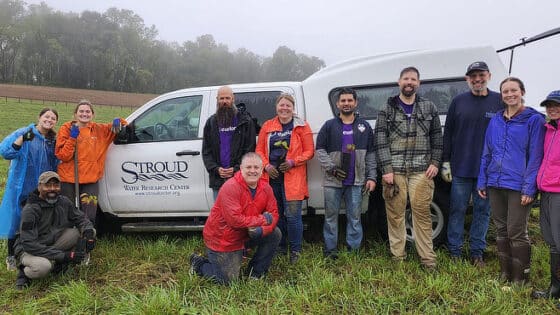
A simple fence installation can reduce pollution by keeping animals (and their waste) out of streams. But how effective is it? Photo: Stephanie Eisenbise
Barclay Hoopes has made a life of farming.
Going on 70, he remembers when his land was surrounded by dirt roads and not much else. While picking stones from out of his field, he looks up every now and then. “It sure is pretty.”
The land means everything to him. It’s his living and the living he hopes his family will inherit. As part of that legacy, he wants to leave the earth a better place than he found it.
“I’ve Done My Best Here”
Hoopes has installed several best management practices (BMPs) on his farm, including a manure management system, fencing to keep his cows from grazing too near a tributary to White Clay Creek, and a recently planted streamside forest buffer.
“There’ve been some real mentors in my life.” Barclay names many individuals and organizations who he credits with helping him be a responsible steward of his land: township supervisors, the Chester County Conservation District, the Stroud Center, and his wife, Diana, recently retired from serving as the program coordinator for Chester County’s Agricultural Land Preservation Board.
“You’ve got to give credit to those who came before you,” he says.
Studying How Farm Practices Can Protect Drinking Water

Drinking-water supplier SUEZ in Delaware’s Stanton Plant relies on the White Clay Creek for two-thirds of its source water.
Hoopes’ farm is one of several sites scientists are studying to determine how well BMPs on farms may protect drinking-water sources from pollution. It was also the first project under drinking-water supplier SUEZ in Delaware’s Watershed Control Plan, a plan that was approved by the Environmental Protection Agency.
SUEZ in Delaware, formerly United Water Delaware, has partnered with several entities to install streambank fencing and vegetated stream buffers.
“Farms offer one of the best opportunities for making water-quality improvements,” says Dave Arscott, Ph.D.
He and fellow Stroud Center scientist Jinjun Kan, Ph.D., are leading the Stroud Center’s contribution to the study.
A simple fence installation can reduce pollution by keeping animals (and their waste) out of streams. But how effective is it? That’s what SUEZ wants to know.
SUEZ services 100,000 people and treats 16 million to 18 million gallons of water per day through its Stanton Plant. The plant relies on the White Clay Creek for two-thirds of its source water.
Knowing the effectiveness of certain BMPs could help SUEZ promote the use of this approach in other watersheds, further protecting source water and assisting other drinking-water providers in meeting regulations defined by the Safe Drinking Water Act.
Promoting Biodiversity and Keeping Streams Healthy
Originally, the Safe Drinking Water Act focused on water treatment as a means of providing safe drinking water. But later amendments added watershed management strategies as an option to stop pollution at its source and to reduce the carbon footprint of water treatment.
Agricultural BMPs like the ones in this study fall into the prevention camp. They can reduce not only nutrients such as nitrogen and phosphorus from entering streams, but also pathogens like Cryptosporidium sp. and E. coli that can cause intestinal illnesses.
Farm BMPs also promote biodiversity and keep streams healthy. And when streams are healthy, they can process nutrients better — acting like nature’s very own water-treatment facilities.

Stroud Center scientists David Arscott, Ph.D. (left) and Jinjun Kan, Ph.D. (right) are working with Kristen Jellison, Ph.D., of Lehigh University to track waterborne pathogens in White Clay Creek. Photo: Kay Dixon
SUEZ’s Stanton Plant is located at the confluence of White Clay Creek and Red Clay Creek, so the research team selected several study sites located within those watersheds. All of the farms are CAFOs, or concentrated animal feeding operations.
Hoopes’ farm will be compared to another farm near the headwaters of White Clay Creek that does not feature the BMPs his farm uses. Unlike Hoopes’ farm, the other paired headwater site currently allows its cows direct access to the stream. A downstream site will also be monitored to determine how upstream characteristics may influence the water downstream.
Capturing Real-Time Data
Real-time wireless sensors are installed at Hoopes’ farm and the other headwater site to capture continuous data during baseflow and stormflow. Kan explains that more contaminants move downstream during storms. “We want to be able to quantify that. It’s important to know when sources of drinking water contain greater concentrations of bacteria and how much greater.”
The researchers will be looking for several disease-causing microorganisms in collected streamwater samples: Cryptosporidium, E. coli, Enterococci, and Bacteroides.
Kan says, “We want to quantify levels of these microbes, and we want to know where they are coming from. Are they coming from humans, cows, or other animals?”
He’ll find out via DNA genotyping. To look for Cryptosporidium, the Stroud Center is working with Kristen Jellison, Ph.D., a Lehigh University professor and researcher. Jellison specializes in tracking waterborne pathogens that can be difficult to detect.
SUEZ Water Quality Manager Mary Neutz says, “SUEZ chose source-water protection as the most environmentally sustainable, cost-effective, and efficient means of increasing water quality and attaining compliance with more stringent regulations to protect public health.”



